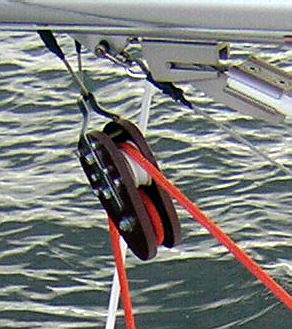Boom brake block
Preventing accidental gybes by using fixed or detachable restraining guys to check the main boom (by restraining its movement or locking it altogether) is an old and proven idea, but the traditional applications of this principle tend to be somewhat cumbersome, both to set up and to handle short-handed. For instance, in circumstances where you can't steer a straight course downwind, but are repeatedly forced to gybe back and forth, simple preventer guys will require additional attention and work.
To deal with this problem there exists a number of proprietary hardware solutions, for example "Scott Boomlock", "Heinson", "Walder" and "Dutchman Boom Brake". What they have in common is the use of a single guy line which is run from one side of the deck or gunwale near the stays to the other side via a friction device. The required friction results from the rope either being wrapped several turns around a plain tube or a special sheave with a spiral grove, or passing fixed or semi-fixed sheaves in a serpentine fashion. The amount of friction is a function of the line tension: high tension locks the boom, less tension allows it to swing across slowly. This variable tension basically depends on both the boom's position and on the pull applied to the line's control end. In some cases pre-adjustments can be made to the sheaves' resistance or friction can even be varied remotely in "real-time".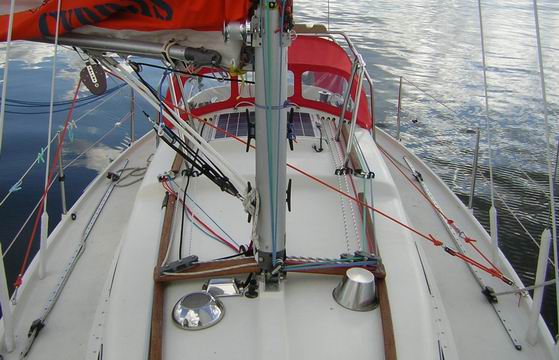 This seemed like a good idea for a DIY project and so I put together this simple friction block consisting of one rotating and two stationary sheaves sandwiched between two sheets of 10mm Tufnol (i.e. fine weave cotton/phenolic resin laminate).
The line is fastened with a carbine hook to a dedicated padeye on the starboard rail, winds its way through the actual brake block towards a turning block which is snap-shackled on the port side rail. This end is parted for a 2:1 purchase and connected to a permanent tail which leads to a jammer by the cockpit coaming.
In use on a dead run, the line is tightened with considerable force by hand and jammed tight. When the sail starts to come across in a controlled gybe the line eased off gradually until the boom, having passed its central position, sedately starts to accelerate towards the other side. This phase is slow enough for the helmsman to be able to pull the main sheet in and then ease out again, controlling the sail through the entire manouvre. Finally, when the course is changed and a preventer is no longer needed, the guy is simply released from its jammer and everything can be left in place without interfering with the sailing.
This seemed like a good idea for a DIY project and so I put together this simple friction block consisting of one rotating and two stationary sheaves sandwiched between two sheets of 10mm Tufnol (i.e. fine weave cotton/phenolic resin laminate).
The line is fastened with a carbine hook to a dedicated padeye on the starboard rail, winds its way through the actual brake block towards a turning block which is snap-shackled on the port side rail. This end is parted for a 2:1 purchase and connected to a permanent tail which leads to a jammer by the cockpit coaming.
In use on a dead run, the line is tightened with considerable force by hand and jammed tight. When the sail starts to come across in a controlled gybe the line eased off gradually until the boom, having passed its central position, sedately starts to accelerate towards the other side. This phase is slow enough for the helmsman to be able to pull the main sheet in and then ease out again, controlling the sail through the entire manouvre. Finally, when the course is changed and a preventer is no longer needed, the guy is simply released from its jammer and everything can be left in place without interfering with the sailing.
Some design considerations worth noting:
- It is important to choose a line that doesn't stretch under load. Naturally it must be sturdy enough to withstand potentially very high forces and also be comfortable to pull by hand.
- The geometry of the whole contraption should be such that the combined distance from the block to the starbord and port padeyes is at its minimum when the boom is in the most forward position, i.e. the length of line required to keep the boom there should be less than in any other position. This way the line will automatically tension itself as the boom aproaches the midship position -- the apex, as it were (the point of maximal combined side-to-block-to-side distance). I tried a few geometries and found that a length difference of approximately 20-25 percent between the minimum and the maximum worked well.
- It is hard to judge the friction provided by the sheaves in the block beforehand, as there are so many variables like sheave dimensions and line material. Therefore it is wise to have a means of adjusting the friction somewhat. I used large hard-rubber shims to add friction to the free-running central sheave in the block, and this can be fine-tuned by tightening the axle bolt. Furthermore serrations were made in the groves of the fixed sheaves, for additional friction.
- If the brake block is going to be used at all it has to be easy to set up (and to put away), as the need arises. I keep the block and guy line permanently latched to the boom, ready for use. It is a matter of seconds to pull out the line, snap the ends fast on both sides, return to the cockpit and start pulling.

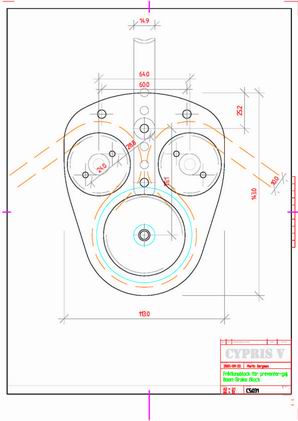
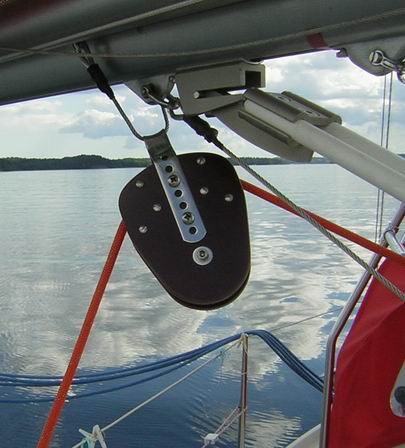
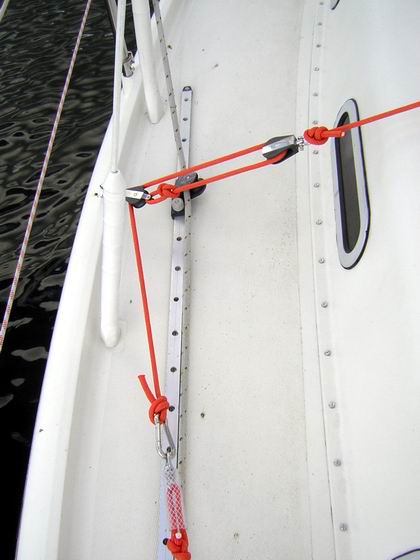
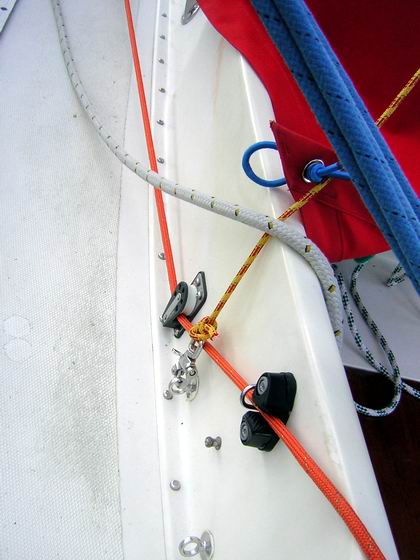
Preventergaj med bombroms
Att förhindra ofrivilliga slänggippar genom att använda en preventergaj av något slag är en gammal och beprövad idé. Traditionella arrangemang tenderar dock att bli svårhanterade för en liten besättning. Vid plattläns i trånga farvatten där man tvingas till upprepade gippar
Följande punkter är värda att tänka på:
- Tågvirket som används i gajen måste vara helt stumt och naturligtvis tillräckligt starkt för att klara potentiellt väldigt stora krafter. Dimensionen får inte heller vara så klen att den skär in i handen.
- Geometrin i hela anordningen måste vara sådan att det sammanlagda avståndet från blocket till styrbords respektive babords fästpunkter är som minst när bommen är i sitt mest utsläppta läge (dvs i praktiken vilar mot sidostaget). På detta sätt kommer spänningen i gajen att öka automatiskt när bommen rör sig mot mitten, punkten med det längsta sammanlagda avståndet (reling-bom-reling). Jag testade några olika geometrier och fann att en skillnad på 20-25 procent mellan minimi- och maximiavstånd fungerade bra.
- Det är svårt att på förhand avgöra hur mycket friktion som i verkligheten kommer att alstras i broms-blocket. Det är många variabler, som blocktrissornas dimensioner och material i linan, etc. Det är därför bra om det finns en möjlighet att finjustera friktionen. Jag placerade tunna brickor av hårdgummi mellan den rörliga trissan och blocksidorna, och klämkraften kan enkelt trimmas genom att dra åt den genomgående axelbulten. Friktionen på de fasta trissorna ökades även genom att täta tvärskåror filades upp i "glidbanorna".
- För att bromsblocks-anordningen skall komma till användning i praktiken måste den vara enkel och snabb att rigga upp (och plocka ner) så fort den behövs. Vi förvarar alltihop beslaget under bommen. Att dra ut och haka fast en krok på varje sida samt ändan till den permanenta haländan, och därefter strama gajen från sittbrunn tar inte många sekunder.


